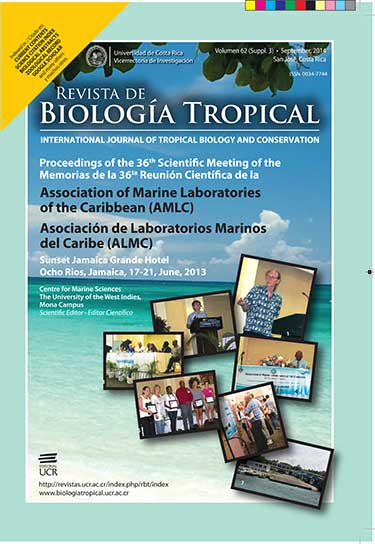Resumen
El parque marino de Xel -Há tiene una población de Strombus gigas que se cría en la zona. Determinamos la relación entre la actividad reproductiva, la densidad de la concha de S. gigas y los parámetros ambientales. Las muestras fueron recolectadas de febrero a diciembre de 2012, utilizando el método de transecto, en cuatro sitios del Parque Marino de Xel -Ha, Quintana Roo, México. Fueron analizados y clasificados utilizando la metodología de Folk & Ward. También se registraron temperaturas, salinidad y oxígeno disuelto. La densidad de concha mostró una baja correlación en la categoría de sedimentos (r = 0.29 , con muy gruesos y r = 0.26 con arena gruesa ), mientras que el apareamiento y desove con arena media mostraron una correlación de r = 0.54 y 0.62, respectivamente. Las densidades en cuatro sitios fueron altas y no se asociaron con el número de apareamientos y desove (r = 0.08 y 0.03, respectivamente). Para la reproducción, S. gigas requiere condiciones específicas de sustrato (efecto arenoso) y no sólo una densidad de 56 Conch Ha-1 (efecto Allee ).
Citas
Aldana-Aranda, D., & Frenkiel, L. (2007). Lip thickness of Strombus gigas versus maturity: a management measure. Proceedings of the Gulf and Caribbean Fisheries Institute, 58, 431-442.
Aldana-Aranda, D. (2006). Overview of reproductive patterns of the queen conch Strombus gigas from different reef systems in the Caribbean. Proceedings of the Gulf and Caribbean Fisheries Institute, 57, 771-790.
Aldana-Aranda, D., Baqueiro-Cárdenas, E., & Manzanilla-Naim, S. (2003a). Mexican marine parks as a fishery management tool for the queen conch Strombus gigas. In Aldana-Aranda, D. (ed.). El caracol rosa Strombus gigas: conocimiento integral para su manejo sustentable en el Caribe. México: CYTED-Press.
Aldana Aranda, D., Cardenas, E.B., Morales, I.M., Ochoa, R.I., & Brule, T. (2003b). Reproductive patterns of Strombus gigas from Alacranes Reef versus Chinchorro Bank of Mexico. Proceedings of the Gulf and Caribbean Fisheries Institute, 54, 202-225.
Aldana-Aranda, D., Cardenas, E. B., Morales, I. M., Ochoa, R. I., Brule, T., & Baez, R. I. O. (2003c). Gonad behavior during peak reproduction period of Strombus gigas from Banco Chinchorro. Bulletin of Marine Science, 73(1), 241-248.
Aldana-Aranda, D., Sánchez-Crespo, M., Reynaga-Álvarez, P., Patiño-Suarez, V., George-Zamora, A., & Baqueiro-Cárdenas, E.R. (2003d). Crecimiento y temporada reproductiva del caracol rosa Strombus gigas en el Parque Xel-Ha, Mexico. Proceedings of the Gulf and Caribbean Fisheries Institute, 56, 741-754.
Aldana-Aranda, D., Sánchez-Crespo, M., Patino-Suarez, V., George-Zamora, A., Baqueiro-Cárdenas, E., Carillo, E., & Pérez, S. (2003e). Abundancia, frecuencia de tallas y distribucion especial del caracol Strombus gigas en el Parque Xel-Ha, Mexico. In Aldana-Aranda, D. (Ed.). El caracol rosa Strombus gigas: conocimiento integral para su manejo sustentable en el Caribe. México: CYTED-Press
Bissada-Gooding, C. E., & Oxeford, H. A. (2010). Estimating Home Range and Density of a Queen Conch Aggregation using Acoustic Telemetry and Conventional Tagging. Proceedings of the Gulf and Caribbean Fisheries Institute, 62, 384-389.
Brito Manzano, N., Aldana Aranda, D., de la Cruz Lázaro, E., & Estrada Botello, M. A. (2006). Organogénesis larvaria de Strombus gigas (Mesogastropoda: Strombidae) en el Arrecife Alacranes durante el período máximo de su época reproductiva. Redalyc, Universidad y Ciencia, 22(1), 75-82.
Brownell, W. N., & Stevely, J. M. (1981). The biology, fisheries and management of the Queen conch Strombus gigas. Marine Fisheries Review, US Department of Commerce, 43(7), 1-12.
Castro-Gonzalez, E. R., Frenkiel, L., Baqueiro-Cardenas, E., & Aldana-Aranda, D. (2007). Atypical reproductive cycle of the queen conch Strombus gigas (Mollusca: gastropoda). Proceedings of the Gulf and Caribbean Fisheries Institute, 58, 443-450.
de Jesús Navarrete, A. (1999). Distribución y abundancia de larvas velígeras de Strombus gigas en Banco Chinchorro Quintana Roo, México. Tesis doctoral, Centro de Investigación y de Estudios Avanzados del Instituto Politécnico Nacional, México.
de Jesús-Navarrete, A., & Valencia-Beltrán, V. (2003). Abundance of Strombus gigas zero-year class juveniles at Banco Chinchorro Biosphere Reserve, Quintana Roo, Mexico. Bulletin of Marine Science, 73, 232-240.
de Jesús-Navarrete, A. (2001). Crecimiento del caracolStrombus gigas (Gastropoda: Strombidae) en cuatroambientes de Quintana Roo, México. Revista de Biologia Tropical, 49, 85-91.
Delgado, G. A., Bartels, C. T., Glazer, R. A., Brown-Petersen, N. J., & McCarthy, K. J. (2004). Translocation as a strategy to rehabilitate the queen conch (Strombus gigas) population in the Florida Keys. Fishery Bulletin, (2), 278-288.
Folk R. L., & Ward, W. C. (1957). Brazos River bar: a study in the significance of grain size parameters. Journal of Sedimentary Petrology, 27, 3-26.
Gascoigne J. C., & Lipcius, R. N. (2004). Allee effects driven by predation. Journal of Applied Ecology, 41, 801-810.
Peel, J. R., & Aldana-Aranda, D. (2012). Growth and population assessment of the queen conch Strombus gigas (Mesogastropoda: Strombidae) by capture mark-recapture sampling in a natural protected area of the Mexican Caribbean. Revista de Biologia Tropical, 60(1), 127-137,
Pérez-Pérez, M., & Aldana-Aranda, D. (2000). Distribución abundancia, densidad y morfometría de Strombus gigas (Mesogastrópoda: Strombidae) en el arrecife Alacranes, Yucatán, México. Revista de Biologia Tropical, 48, 51-57
Randall, J. E. (1964). Contributions to the biology of the queen conch, Strombus gigas. Bulletin of Marine Science, 14(2), 246-295.
Stoner, A. W., & Ray-Culp, M. (2000). Evidence for Allee effects in an over-harvested marine gastropod: density-dependent mating and egg production. Marine Ecology Progress Series, 202, 297-302.
Stoner, A. W., Sandt, V. J., & Boidron-Metairon, I. F. (1992). Seasonality of reprodutucive activity and abundance of veligers in queen conch, Strombus gigas. Fishery Bulletin, 90, 161-170.
Fig. 1. Study area, Xel-Ha Park in the Mexican Caribbean, indicating four samples sites: Bocana, Centro, Brazo Norte and Cueva.
##plugins.facebook.comentarios##

Esta obra está bajo una licencia internacional Creative Commons Atribución 4.0.
Derechos de autor 2014 Revista de Biología Tropical






